Scan 3XS i3 OC Gaming PC Review
Scan 3XS i3 OC Gaming PC
Scan's latest budget gaming system has one of Intel's new Core i3 processors overclocked to 4GHz at its heart.
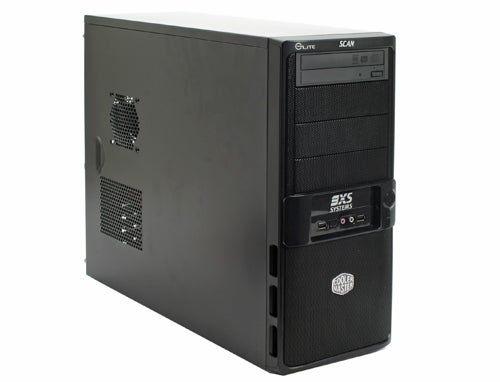
Verdict
Key Specifications
- Review Price: £702.65
In October of last year we were planning to get a few gaming PCs in between £600 and £700, of which the £599 CyberPower Infinity i5 Hercules SE was the first. However, after that DinoPC seduced us into reviewing the more expensive i7-Osuarus, and other system assemblers had trouble getting their entrants ready. Now it’s a new year though, and with it we have a new budget gaming PC: the Scan 3XS i3 OC, which comes in at just £2.65 over £700. 
What does this get you in 2010? For starters, as its name suggests this Scan is based on an overclocked version of one of Intel’s newest Core i3 chips (keep in mind that though these are newer they’re not necessarily better than what has come before, as they lack the dynamic clock speeds and some features of their more expensive Core i5 and i7 siblings). This is backed by one of AMD/ATI’s new 5000-series DirectX11-compatible graphics cards offering Eyefinity triple-monitor support, with the usual 4GB of DDR3 RAM onboard and a 500GB hard drive for permanent storage.
The Scan 3XS i3 OC comes packaged in more protective padding than any other PC we have seen, with even the inside of the case literally stuffed with insulation to protect its precious components during transit. Despite the huge box it arrived in, the case itself is small by gaming standards and, along with the Infinity i5 Hercules SE before it, it’s one of the lighter tower PCs to come through our offices.
Though it also bears the Scan logo in embossed silver letters, the case for this system is a CoolerMaster Elite 335. On the outside this black mid-tower is certainly a neat affair, consisting of smooth steel panels on the sides and a metal mesh honeycomb-pattern front with a matt plastic surround and glossy plastic connectivity panel.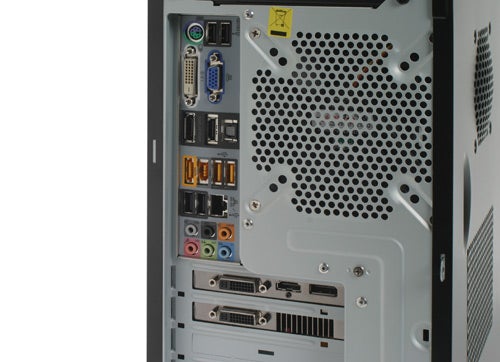
At the case’s front you’ll find a matt black Sony 24x DVD-Rewriter, and it’s nice to see that this is a SATA model when some assemblers are still shipping machines with EIDE optical drives. Connectivity here is as basic as it gets though, with just two USB 2.0 ports plus 3.5mm jacks for headphone and microphone alongside the blue-backlit power button and pinhole reset button.
Around the back, on the other hand, is a veritable plethora of connections. There are six USB ports, FireWire/1394 and eSATA sockets, Gigabit Ethernet, a single PS2 mouse/keyboard port, six analogue jacks and digital optical for audio, plus VGA, DVI, HDMI and DisplayPort from the motherboard’s integrated graphics. The latter are made redundant by the video card, though, which offers even more by swapping the analogue output with a second dual-DVI output.
To open the CoolerMaster Elite 335 up, you simply remove two thumb-screws and the side panel slides off smoothly. This reveals one of the most spacious interiors we’ve yet come across, thanks to the use of a mini-ATX motherboard inside a case that’s built to accommodate full ATX boards. The ‘mini-ATX motherboard in a large case’ approach is another thing this PC shares with the cheaper CyberPower Infinity i5 Hercules SE, except that Scan has done an even more impressive job of tidying the cables in a case that only offers minimal options in this regard.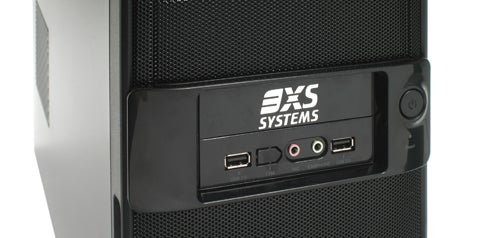
If we had to sum the Elite 335 case up in a word it would be ‘competent’. Most edges are nicely rounded but there are a few sharpish ones here and there. In addition to the 80mm fan mount on the removable side panel (the shroud has been removed because Scan uses a custom cooler on the i3 processor), it’s possible to mount a 90mm fan above the graphics card area and there are 120mm fans at the front and back so air-flow should be ample. In terms of noise this setup is middle of the road. With it producing a very audible hum even when idle it’s certainly not silent, but neither does it get disturbingly loud.
At the front of the case there are three free 5.25in drive bays and a single 3.5in bay which would be ideal for adding a memory card reader. Inside there is a cage which can hold a further five 3.5in drives, and though this does not face outwards, both optical and hard drive cages do at least sport a tool-free clip system. It’s one of the easiest systems we’ve come across and works really well, with the only niggle being its lack of vibration-dampening. It’s surprising then that Scan has opted to screw in the system’s single hard drive, though of course this does mean it’s as secure as it can get. 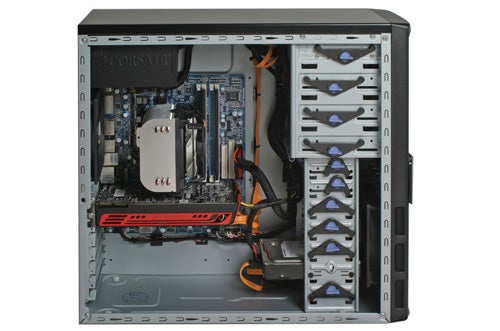
Getting onto the components inside, as mentioned this system is based on one of Intel’s brand-new Core i3 processors, specifically the Core i3 530, which is a Dual Core CPU running at 2.93GHz stock. It features Hyper-threading so appears as a quad core CPU, but lacks Turbo Boost so doesn’t dynamically overclock like the more expensive Intel chips. There’s also an integrated graphics chip, though with a separate graphics card in this system, it probably won’t be used.
So far this CPU might not sound too exciting, which isn’t too surprising considering it’s a budget part. Scan hasn’t just left it at its default clock speed, however, overclocking it by a whopping 1007Hz (1.07GHz) to give you a total of 4GHz. Consequently the Core i3 holds it own against significantly more expensive processors in many scenarios, including the Core i7 860 used in the £1,000 i7-Osuarus. It’s certainly more than up to running most games as fast as the graphics card will allow.
Though such an overclock would be possible with the stock cooler, Scan has played it safe and gone with something a little beefier. Arctic Cooling’s Freezer 7 Pro V2 does a good job of preventing your CPU from turning into toast (we measured a maximum of 70 degrees) and is configured to send the hot air straight to the case’s rear exhaust fan, leaving the system’s insides relatively cool.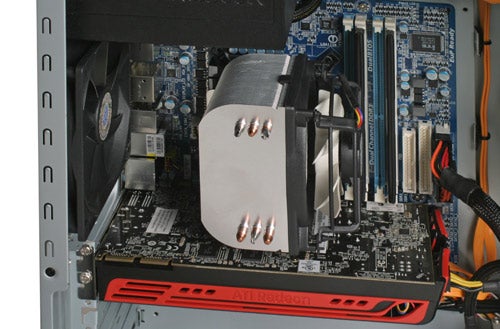
For memory duties four gigabytes is the norm nowadays and as much as all but the most demanding games will use. In Scan’s case it has filled two of the motherboard’s available four slots with Corsair-branded XMS3 1,600MHz DDR3 memory, which look great with their black heatspreaders.
Speaking of the motherboard, as mentioned earlier it’s a mini-ATX affair based on Intel’s new H57 chipset. Gigabyte has gone for an attractive blue and white colour scheme, with a small metal cooling block over the northbridge. As far as slots go you get two PCI-Express x16 slots supporting ATI’s CrossFire technology (with each card getting x8 bandwidth), allowing you to add a second video card at a later date. In case you were wondering, the 400W Corsair non-modular power supply should be able to handle a second HD 5770 without any problems.
In addition to the outdated EIDE HDD and floppy connectors the motherboard also sports five SATA ports, four of which are occupied by pre-routed cables allowing you to add either an optical or hard drive to the installed models. At least as far as permanent storage is concerned you might end up doing this rather quickly too, as games take up a lot of space and the 500GB provided by the 7,200rpm Samsung Spinpoint F3 is a bit stingy these days.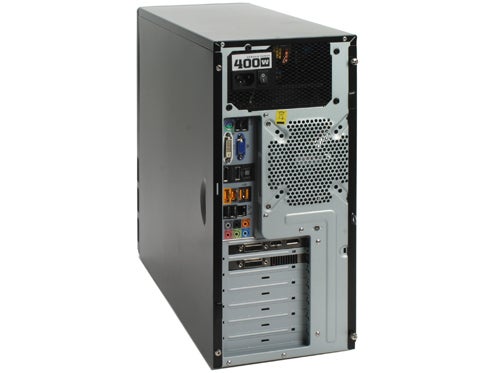
As always the highlight of any gaming PC is going to be its graphics card, and while not the top of ATI’s line, as part of the 5,000-series the XFX HD 5770 does offer the best feature set on the market and won our coveted Recommended Award by offering excellent performance for its price. Most important for gamers among its features is of course DirectX11 support, which is likely to gain wider support than its predecessor did. ATI’s Eyefinity technology, meanwhile, will let you hook up three monitors out of the box, though anyone who can afford that setup can probably afford a better PC too.
As expected, the 64-bit version of Windows 7 Home Premium is the OS of choice. It’s a very clean install with some benchmarking and burning-in tools the only installed applications and a very dull Scan wallpaper as the default background.
But now to the big question: how does this affordable gaming system actually perform in games? Most titles are handled with ease as long as you don’t go beyond Full HD resolution; for instance, Call of Duty 4 on maximum detail returned a silky 98fps at 1,920 x 1,200. Crysis in DirectX10 posed more of a challenge, and to get a really smooth gaming experience on high detail we had to drop the resolution down to 1,680 x 1,050 (for an average of 33.15fps) but it’s still a very respectable show for a machine of this price. 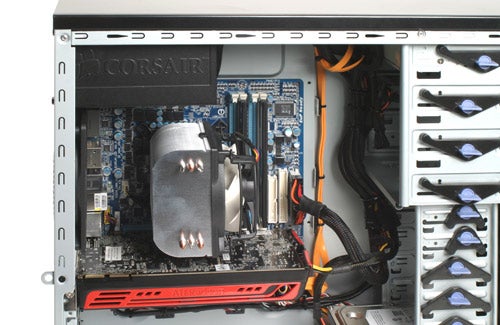
DirectX11-compatible titles are where this card has a real chance to flex its muscles though, as demonstrated by the excellent result it achieved in Stalker: Call of Pripyat; an 63.5fps average on Ultra Detail at 1,920 x 1,200 is nothing to sniff at.
Looking now at value, the most interesting comparison is with CyberPower’s £600 Infinity i5 Hercules SE, which offers a better processor for less money. However, the overclock Scan has applied more than negates the Core i5’s advantage, except in heavily multi-threaded applications where the latter’s four physical cores still give it the upper hand – and of course the Core i5 750 is an excellent overclocker too.
Regardless, the simple fact of the matter is that graphics rule and here the £702.65 Scan also beats the CyberPower thoroughly, though admittedly it’s only a £50 upgrade to equip the i5 Hercules SE with an HD 5770. Also, prices have changed since we reviewed that system, so now a similarly-specified Cyberpower PC (with its Core i3 overclocked to between 3,600 and 3,900MHz) will set you back around the same. Obviously the Scan will still be faster and we like the company’s use of a fully-featured mini-ATX board, but the biggest differentiating factor will be warranties, with Scan offering one year on-site plus another year standard and free lifetime phone support, while CyberPower gives you three years standard and free lifetime phone support – of those we prefer Scan’s option as on-site is obviously far more convenient.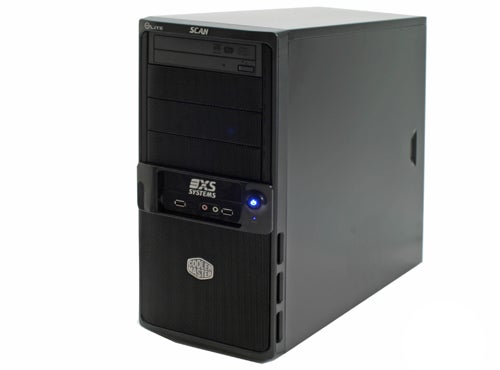
Another interesting option is currently offered by Dell, which has a Studio XPS running a Core i5 650 at 3.2GHz stock, with 6GB of 1066MHz DDR3 RAM, the same HD 5770 graphics card and 2TBs-worth of hard drive space for just £719! However, if you do possibly see yourself doing some upgrading of your own down the line, the proprietary nature of the Dell system will severely limit what you can do, with the main drawback being its apparent lack of CrossFire support.
Verdict
An impressively overclocked system with a good balance of components, Scan’s 3XS i3 OC Gaming PC provides decent performance for the price.
Addendum – 01/02/10: The Dell Studio XPS mentioned above has gone up to £809 since time of writing, and we originally thought the warranty on Scan’s system was inferior to what it turned out to be. As the 3XS i3 was a borderline eight in value to begin with, we have upped its value score (and therefore overall score) to reflect this.
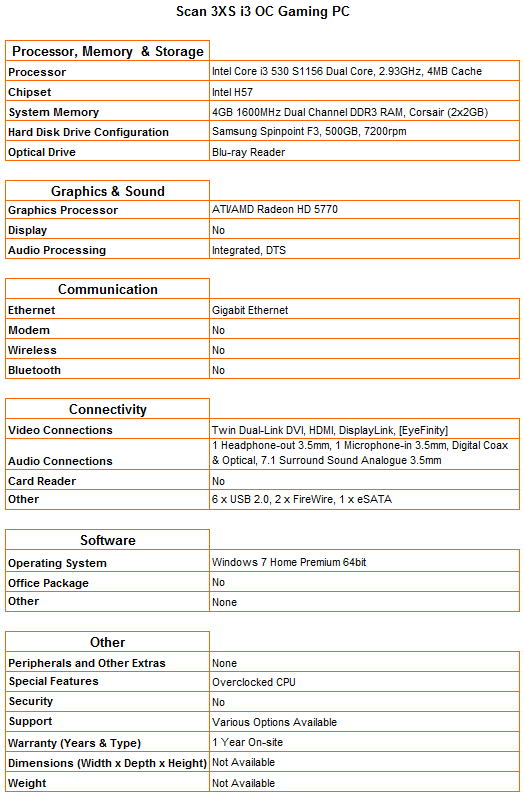
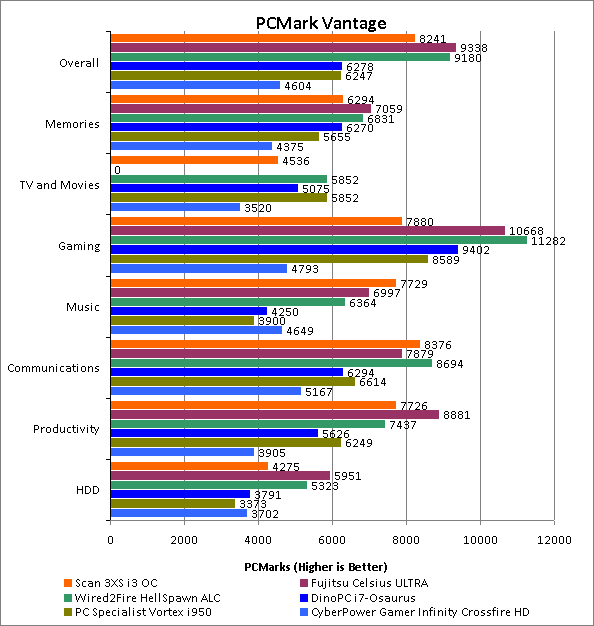
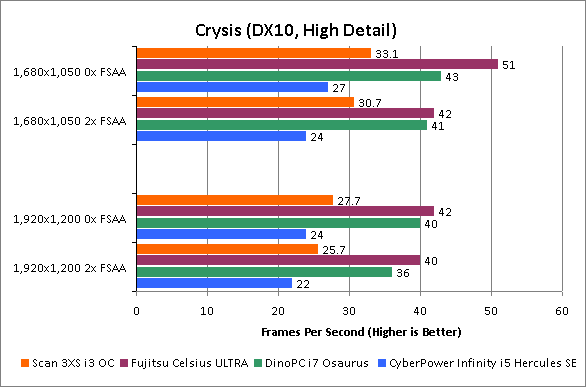
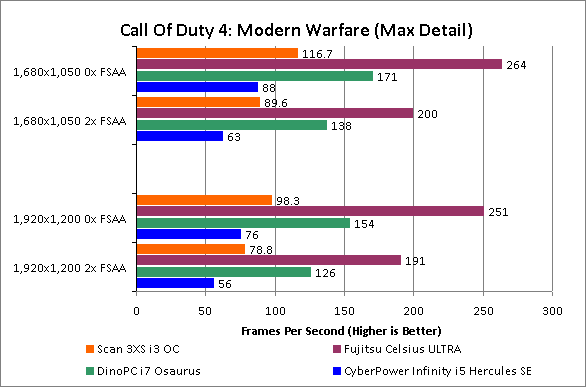
Trusted Score
Score in detail
-
Value 8
-
Features 8
-
Performance 8
-
Design 6

